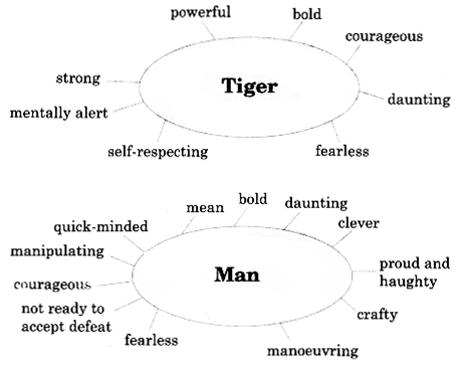NCERT Solutions for Class 9 English Main Course Book Unit 3 Environment Chapter 3 Save the Tiger are part of NCERT Solutions for Class 9 English. Here we have given NCERT Solutions for Class 9 English Main Course Book Unit 3 Environment Chapter 3 Save the Tiger.
| Board | CBSE |
| Textbook | NCERT |
| Class | Class 9 |
| Subject | English Main Course Book |
| Chapter | Unit 3 Chapter 3 |
| Chapter Name | Save the Tiger |
| Category | NCERT Solutions |
CBSE Class 9 English Main Course Book Unit 3 Environment Chapter 3 Save the Tiger
TEXTUAL EXERCISES
(Page 63)
Question 1.
What is your opinion about ‘Animals behind bars’ ? Share your views with the class.
Answer :
My opinion about ‘Animals behind bars’ is rather sad. I see them as prisoners who have been snatched out of their natural habitat and their own families. They can’t move as they like. But they have to walk in the iron cages which are now their homes. This way they are virtual prisoners in them. So their ‘freedom’ has been snatched away from them and it is the most atrocious. That’s why, we can see their weak bodies and blank faces. They live but in a dying way.
Their pathetic condition can be felt by placing ourselves in a dying way. Thus these animals behind bars need to be released in the wild at once. But it seems a far-fetched wish.
Question 2.
Read through the poem and quickly make a note of any thoughts that come to you, while you are reading it.

Dispute :
A man and a tiger once had a dispute, Which was reckoned greater, the man or the brute. The tiger discoursed on his side at some length, And greatly enlarged on his courage and strength, Said the man, ‘Don’t be prating; look yonder, I pray, At that sculpture of marble: now what will you say? The tiger is vanquished; but as for the man, He is striding upon him: deny if you can.’ ‘But pray,’ said the tiger, ‘Who sculptured that stone? ‘One of us,’ said the man. ‘I must candidly own.’ ‘But when we are sculptors,’ the other replied, ‘You will then on the man see the tiger astride.’ Anonymous.
Answer :
No question asked.
Question 3.
Answer the following questions by ticking the correct options :
1. What was the cause of the dispute between the tiger and the man ?
(a) to establish who was superior.
(b) to prove beasts were inferior.
(c) to justify that beasts should be caged.
(d) to prove that man was more intelligent.
2. What did the man do to prove his point ?
(a) he caged the tiger.
(b) he carved a statue of a man riding a tiger.
(c) he put the tiger in a cage.
(d) he enslaved the tiger.
3. What was the tiger’s counter-argument ?
(а) he said that he was the king of the jungle.
(б) he claimed he ruled the world.
(c) he said the situation would be reversed if he was the sculptor.
(d) he threatened to devour the man in a moment.
Answer :
1. (a)
2. (b)
3. (c)
Question 4.
In pairs discuss the qualities and characteristics of the tiger and the man. Complete the web charts.


Answer :
To be discussed in pair. Some answers are given below :

Question 5.
Working in groups of four, write a dialogue between :
- A tiger behind bars and a man
- A man in a cage and a tiger

Answer :
For working in groups of four. One type of dialogue is given below :
Man to the tiger in the cage : Hai ! see how I have caged you !
Tiger : Yes, but one day I shall set you in my place.
Tiger to man in the cage : Hai ! how do you feel being caged like this ?
Man : I wonder how you have done this !
Tiger : Now tell who is stronger ?
Man : Time will tell.
Tiger : Now you see how I felt when I was forced to be in the cage. Loss of freedom is like a living death.
Man : We are the rulers and shall reverse this situation…
Question 6.
Listen to the extract on Tigers and as you listen, complete the summary given below.
Save Tigers :
The price of human greed is being paid by yet another animal species the Tiger. Today the tiger population is getting depleted at an alarming rate. According to a recent survey, one tiger is being poached everyday. If the present state of affairs is allowed to continue, the next generation will not get to see the majestic animal even in the zoo.
It is high time that action is taken to protect and conserve the tigers in order to maintain the ecological balance. Stringent laws against poachers must be enforced. It is over 40 yrs since the tigers became our national animal. As a result, the species was to be protected. Ironically, they are closer to the edge of extinction now than ever before. Children, scientists, conservationists, NGOs and institutions in India and world wide have put their heart and soul into trying to save the tiger. Yet there is little we all have been able to do. The responsibility and the power of protection lies with the government, specifically the forest department.
Let us not forget that if we destroy nature, ultimately we will be destroyed ourselves. Tiger, an apex predator is an indicator of our ecosystem’s health. Saving the tiger means we save the forest, since tiger cannot live in places where trees have vanished, and in turn secure food and water for all.
Tigers are now an endangered species. Today there are about 5000 to 7,400 left in the world. Three types of tigers – The Bali, Javan and Caspian tigers have become extinct. The two reasons why tigers are endangered are: Habitat loss and illegal killing.
Illegal Killing :
One of the most important aspects to recognise in threatening our national animal is poaching. Tigers are killed to make rugs and coats out of their skins. In many Asian cultures medicines made from tiger’s parts are believed to cure diseases.
Habitat Loss :
Forests where tigers live are cut by humans for farming, building houses and roads. This leads to tigers becoming homeless and foodless. Since other animals also die when forests are cut, it leads to tigers becoming weak and ultimately dying.
Project Tiger :
Project Tiger is a wildlife conservation project initiated in India in 1972 to protect the Bengal Tigers. It was launched on April 1, 1973 and has become one of the most successful wild life conservation ventures. The project aims at Tiger conservation in specially constituted Tiger reserves representative of various bio – geographical regions through out India. It strives to maintain a viable conservation reliant on tiger population in their natural environment.
Project Tiger was Indira Gandhi’s pet project. The main achievements of this project are excellent recovery of the habitat and consequent increase in the tiger population in the reserve areas, from a mere 268 in 7 reserves in 1972 to above one thousand in 28 reserves in 2006.
Tigers being at the apex of the food chain can be considered as the indicator of the integrity of the eco system. They can be found in a wide range of habitats, from the evergreen and monsoon forests of the Indo-Malayan realm to the mixed coniferous – deciduous woodlands of the Russian Far east and the mangrove swamps of the Sundarbans, shared by India and Bangladesh.
Tigers are mostly nocturnal but in the northern part of its range, the Siberian subspecies may also be active during the day at winter-time. All wild tigers live in Asia, others live in the humid jungles of Sumatra. The body length is 140 – 280 cm and the tail length is 60 to 95 cm. The upper part of the animal ranges from reddish orange to ochre and the under parts all whitish. The body has a series of black striations of black to dark grey colour.
Answer :
No question asked.
Question 7.
Fill in the blanks :
- The next generation is not likely to see the tiger because of.
- laws against poachers must be enforced.
- The responsibility of protection of the tiger lies with the
- One of the reasons for the Tiger becoming extinct is
- Destroying nature means
- ….., ….., and are different types of tigers.
- is a wild life conservation project.
- Tigers are found in the evergreen and monsoon forests of the
- Though tigers are mostly nocturnal, species may also be active during the day.
- The body length of the tiger is cm.
Answer :
- depletion of tiger population/extinction of tigers
- Stringent
- government, specifically the forest department
- poaching/habitat loss
- destroying ourselves
- The Bali, Javan and Caspian tigers
- ‘Project Tiger’
- Indo-Malayan realm
- Siberian sub
- 140-280
Question 8.
Read the information given below. Do you know that tigers are the biggest cats in the world? There are five different kinds or sub-species of tiger alive in the world today. Tigers are called Panthera tigris in Latin, Bagh in Hindi & Bengali, Kaduva in Malayalam & Pedda Puli in Telugu.
Total Population of Tigers in the world :


Extinct Species :
- P.t. virgata (Caspian Tiger)
- P.t. sondaica (Javan Tiger
- P.t. balica (Bali Tiger)
Tiger in Trouble :
Since some tiger parts are used in traditional medicine, the tiger is in danger. Apart from its head being used as a trophy to decorate walls, tigers are also hunted for the following.
Head : As a trophy on the wall.
Brain : To cure laziness and pimples.
Teeth : For rabies, asthma and sores.
Blood : For strengthening the constitution and will power.
Fat : For vomiting, dog bites, bleeding haemorrhoids and scalp ailments in children.
Skin : To treat mental illness and to make fur coats.
Whiskers : For toothache.
Question 9.
After reading the information given in C.8, complete the table given below by
filling in the blank spaces.

Answer :
(a) China
(b) 12
(c) 20
(d) 2500
(e) 3800
(f) 30
(g) Sumatra
(h) 500
Question 10.
‘Massive poaching in the past two years has wiped out the entire tiger population at one of the tiger reserves in India,’ says one of the investigation reports. Study the information in C.7 and C.8 and notice how the number of tigers are falling. Using the information, write a paragraph in about 150 words on Project Tiger.
Answer :
Project Tiger :
It is sad that the next generation may not see the tiger if poaching goes on as it is today. Govt, must check it, otherwise we shall see a threatening to our existence too. Three species of tiger—The Bali, Javan and Caspian—are already extinct. ‘Project Tiger’ is a good project to save this species.
A tiger covers ten metres in its horizontal leap. Most tigers have more than 100 stripes and no tigers have identical stripes. The roar of a tiger can be heard from more than a mile away. Tigers are largely muscular. They rely on stealth and power rather than on speed to kill their prey.
There are different species of tigers. China has Amur subspecies of tigers. Their number ranges from minimum 12 to maximum 20. It has another species called Indo-Chinese (N.E.) whose number varies from 415 to 476. Sumatran Tigers range from 400 to 500 in number.
‘Project Tiger’ aims at saving the tiger from extinction. Tigers are at the head of the food chain and very indispensable for the maintenance of the ecological balance of nature. This ensures life to all.
We hope the NCERT Solutions for Class 9 English Main Course Book Unit 3 Environment Chapter 3 Save the Tiger help you. If you have any query regarding NCERT Solutions for Class 9 English Main Course Book Unit 3 Environment Chapter 3 Save the Tiger, drop a comment below and we will get back to you at the earliest.